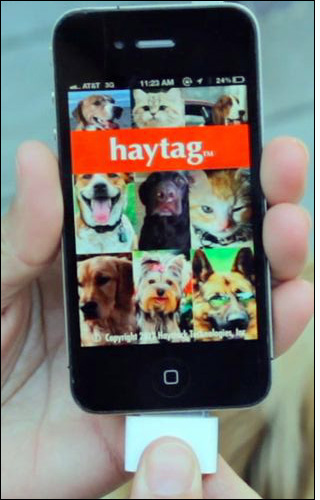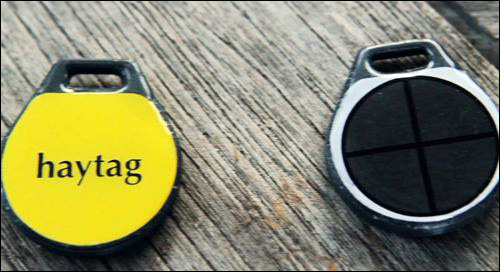A year ago, a startup called Haystack Technologies launched its H-Builder development platform to enable companies and individuals to create solutions based on the Dash7 (ISO 18000-7) standard and OpenTag open-source firmware library for active 433 MHz radio frequency identification tags and readers. But recently, the firm began marketing its own products, the first of which focuses on locating missing pets. The HayTag—for which orders are now being accepted, and which will begin shipping in March 2013—consists of an active 433 MHz RFID tag that can be attached to a pet’s collar, and works in conjunction with the Haystack Adapter, an RFID reader that plugs into an Apple iPhone, iPad or iPod Touch. The system is expected to work with Android phones by mid-2013.
Patrick Burns, Haystack Technologies’ cofounder and CEO, was a member and cofounder of the Dash7 Alliance, where he oversaw the development of the open active RFID standard. Burns says he thought of the HayTag pet-tracking idea while jogging around his neighborhood, where signs for a lost dog were posted. “I knew this would be an easy one to solve,” he says, noting that the existing solution—low-frequency (LF) microchips implanted in animals—has limitations. Such a system, he explains, works only if a veterinarian has the appropriate reader to interrogate the tag at close range, which doesn’t help a pet owner immediately if that person’s pet ends up missing.
At the time, Haystack Technologies had also been developing a reader adapter that can be plugged into an iPhone or other Apple product, thereby enabling it to read Dash7 tags. Over the course of a few months, the company created the HayTag solution.
The tag is the shape and size of a regular dog tag, but measures approximately 3 millimeters (0.12 inch) thick. Its built-in solar cell harvests and stores enough electricity to power the tag for days—typically, after 20 minutes outdoors in daylight, or after 10 hours of indoor light. Power consumption is low, Burns says, because the tag remains dormant until detecting a reader’s transmission.
To use the reader, a user must first download a free Haystack application (which is expected to become available in March at the iPhone app store) onto the phone into which the adapter will be plugged. The app then enables the user to read the tag’s ID number and enter any details about the dog, such as its name. If the owner notices that the dog is missing, he or she would then plug the reader into the iPhone, iPad or iPod Touch, and, using the app, select a prompt to search for that animal’s tag. If the dog’s tag is within 1 kilometer (0.6 mile) of the reader, it will detect the reader’s signal and transmit a response. Once the interrogator receives that response, it will measure the signal’s strength to calculate how far away the animal’s tag is. The app provides a display that changes color and emits beeps as the user gets closer or farther from the signal, and thus the animal.
If many parties adopt the system, Burns says, other individuals can use the app and RFID reader to assist with the searching process. They would simply set their own phones to transmit, and wait for a response from a dog tag. In this way, members of a community, whether or not they know each other, can share the task of seeking lost pets. To initiate such a search, a dog or cat owner would utilize the HayTag app to issue a request for help to other phones in the area running the HayTag app. That request—sent as a text message—would include the ID number of the animal to be located, and recipients of the message could then set their phones to seek that particular ID.
In February 2013, the Peninsula Humane Society, located in Burlingame, Calif., plans to test the HayTag system, and will provide tags to some pet owners for home use. The technology seems promising to Scott Delucchi, the Peninsula Humane Society’s community relations senior VP. “People are still doing what they did a hundred years ago,” he states. Namely, when a person loses a pet, he or she typically posts a sign describing the animal and how to contact the owner. Of the stray dogs and cats that are brought to the Peninsula Humane Society, Delucchi says, less than half are ultimately reunited with owners, while only about 4 percent of cats are ever claimed.
If those who trial the technology at home find it useful, Delucchi says he could envision either selling the solution to those who adopt pets at the shelter, or offering it with each pet, with the cost built into the adoption fee.
The HayTag has attracted the attention of various companies, including a manufacturer of brand-name pet products that might want to sell the solution. In addition, a sporting goods company is interested in using the system to track items, rather than pets. In this case, the tags could be applied to snowboards or other high-value sports equipment, in order to help owners track them if something ends up missing. Burns declines to name either firm, however, since plans are still in discussion.
What’s more, Burns says, the technology could also work with livestock. In that case, he envisions the HayTag being attached to the ear of a cow or other animal. The tag could be linked to a temperature sensor or an accelerometer, to not only help locate livestock, but also send a transmission if, for example, an animal has an elevated temperature or stops moving—indicators that it might be sick.
The system can be set up to issue alerts if a pet strays too far from a phone. In such a scenario, a phone’s adapter would send a transmission at preset intervals, and in the event that it failed to receive a response, or if the response signal was weak, the phone could then sound an alert.
Currently, the system costs $99 for a single RFID tag and a Haystack Adapter reader, via the Indiegogo crowdfunding Web site, with additional tags costing $49 apiece. However, Burns expects the tag price to drop below $30 as the company begins shipping in higher volumes. Haystack Technologies is also marketing a kit that includes four tags and two Haystack Adapters for $299, for use with an iPhone, iPad or iPod Touch.
The Dash7 standard originated from an active ISO 18000-7 standard used for RFID company Savi‘s active, long-range technology provided to the U.S. Department of Defense. The Dash7 Alliance has since established an open protocol, and Dash7 Mode 2 was adopted earlier this year (see Dash7 Alliance Working on New Specification, Tags for ISO 18000-7).




